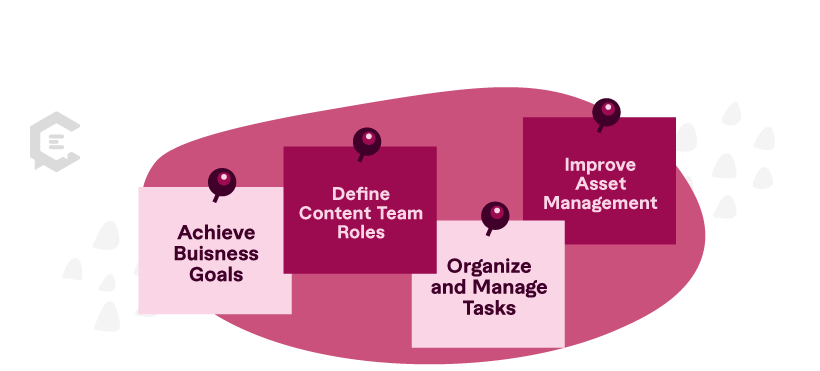Your content production strategy can lead to either success or failure of your content marketing campaigns — there is no in-between.
Content is the building block of digital marketing campaigns. And to get great results, you need great content pieces. Keep reading for guidance on creating a content production strategy that hits marketing goals.
What is content production?
Content production is the planning and creation of informative content and media in various formats. This includes blog posts, white papers, videos, newsletters, infographics, industry reports, and podcasts.
The content types produced depend on multiple factors, such as:
- Target audience
- Who is the content for?
- What are the content types they prefer to consume?
- Content distribution channel
- Where will you publish the content?
- What content types get the most engagement in those channels?
- Available resources
- Do you have the budget and talent needed for specific content types?
- Does your team have the tools needed to produce them?
- Your marketing goals
- What do you want to achieve with your content?
- How will you align your content with your business goals?
To succeed, take the time to create a clear strategy with these factors in mind. This helps the content process run smoothly, efficiently, and purposefully.
Why do you need a strategy for producing content?
Building a solid strategy for producing content will unlock the actual value of your content. To build a sound strategy, look at the following:
Achieve business goals
Your content strategy ensures every piece contributes to your business goals. You can use content to raise brand awareness, bring in leads, generate sales, increase search engine rankings, and so on.
Define content team roles
With your goals defined, identify your best-fit subject matter experts (SMEs), editorial team, translators, and content creators.
Your content creation team may consist of writers, graphic designers, video editors, and other professionals. This depends on the types of content you need to produce.
Organize and manage tasks
An effective content production strategy answers questions related to content projects. For example, what keywords should you target to optimize a piece for search engines? Who will you assign to create it? When is the first draft’s due date?
Improve asset management
Content production involves collaboration tools that improve your team’s asset management.
Assets like photos, image editing tools, reference materials, and keyword lists help content creators complete their tasks faster. With a well-planned content production strategy, you give your team more accessible access to these resources.
Essential content production tools
Most content tools have a software side that helps team members with their tasks. This is important, primarily if you work with freelancers, agencies, and remote employees.
Below are the tools to help you create a content production strategy that gets results:
1. Project management system
Project management systems provide a single dashboard for managing different areas of content production.
For example, Notion and Trello are among the top choices for content production teams. They will help you assign tasks, track deadlines, provide feedback, and share valuable resources (content assets, guidelines, etc.).
2. Asset management software
Most tools in content creation enable asset management through integrations or built-in features.
Canva, for instance, makes collaboration more manageable by letting you share links. Social media marketing tools like Hootsuite provide built-in content libraries for assets like images, videos, and templates.
If you want a dedicated asset management solution, consider cloud storage services like Google Drive, Dropbox, and Microsoft OneDrive. Be sure to select services that support integrations with other apps and services you use.
Bonus tip: Use multiple storage tools to house different asset types.
3. Content calendar
A content calendar ensures the timely completion of content production tasks.
Using a traditional calendar or whiteboard for in-house teams will help keep everyone on the same page. A content calendar with online collaboration features is better when you use distributed teams or external resources like freelancers and content agencies.
Services like Google Calendar enable seamless sharing and scheduling between team members. Alternatively, use the built-in content planning calendars in marketing tools like CoSchedule.
4. Communication tool
Communication software like Skype, Slack, and Zoom accelerates the feedback cycle and brainstorming sessions. They also come with add-on features that improve productivity.
For example, Slack lets you define communication channels for specific, focused conversations. During brainstorming sessions, Zoom’s automatic recording tool for training, evaluation, and reference purposes.
How to create an effective content production strategy
It’s time to create your content production strategy using everything you have learned thus far.
Step 1: Define your goals
Set clear goals to guide your decisions in creating a content production strategy. At this stage, you need to focus on long-term, top-level goals—not specific goals for individual content pieces or campaigns.
Consider the following questions.
- Do you need to establish an authoritative social media presence?
- Does your company want to increase your website’s search engine rankings?
- Do you need to nurture leads through email marketing?
The answers will help you decide the content production tools and tactics to include in your strategy.
Step 2: Plan your content production software ecosystem
Take the time to identify the content production tools you need to fulfill your goals.
If you plan to launch email marketing campaigns, check out Mailchimp, GetResponse, and Sendinblue. For a more substantial social media presence, look at content planning and scheduling tools like Hootsuite and Later.com.
It’s also important to build the back end of your software stack. This pertains to essential content production solutions that you can use for all projects.
Some examples are:
- Cloud storage services
- Project management platforms
- Content management system
- Graphic design tools
- Word processing software
- Keyword research tools
Step 3: Assign team roles
Ensure everyone in your content production team understands their roles and responsibilities.
Don’t just focus on content writers. Your editors, fact-checkers, SEO experts, and content strategists also need a clear and descriptive list of their responsibilities.
Weave tasks together into a seamless content production workflow, like:
Step 4: Develop content guidelines
Round up your editorial team and have them create content guidelines. This will help to keep future content on-brand and satisfactory quality-wise.
Mention your audience personas, language, brand safety guidelines, and stylistic preferences. Better yet, create ready-to-use content templates to spur your content team’s productivity.
Project management software provides an avenue for sharing crucial content guidelines and templates. A typical strategy involves the following steps:
- Create and compile content guidelines (as a PDF, Word document, etc.).
- Upload the document to a cloud storage, asset management, or project management solution.
- Ensure team members have permission to access it.
Bonus tip: Establish file naming and folder organization conventions. This will make it easier for your editorial team to find the right assets whenever necessary.
Step 5: Measure results
Track results to improve your content process over time. Evaluate the performance of everyone involved in production to identify bottlenecks.
Does your team use too many tools?
Do your writers or graphic artists struggle with particular content guidelines?
Are the pieces you publish actually helping your marketing objectives?
Use internal reports and project management data to monitor your team’s performance. For the actual performance of content pieces, use analytics tools baked into marketing platforms. Also, look at website traffic analytics through software like Google Analytics.
Ramp up content production
Your content production strategy can ultimately make or break your ability to hit your digital marketing goals.
Be sure you acquire the right tools, bring in the right people, and create the proper workflows. Producing great content isn’t always easy, but it’s more than doable with the right components.
If you need more hands on deck, reach out to one of our content experts today.







